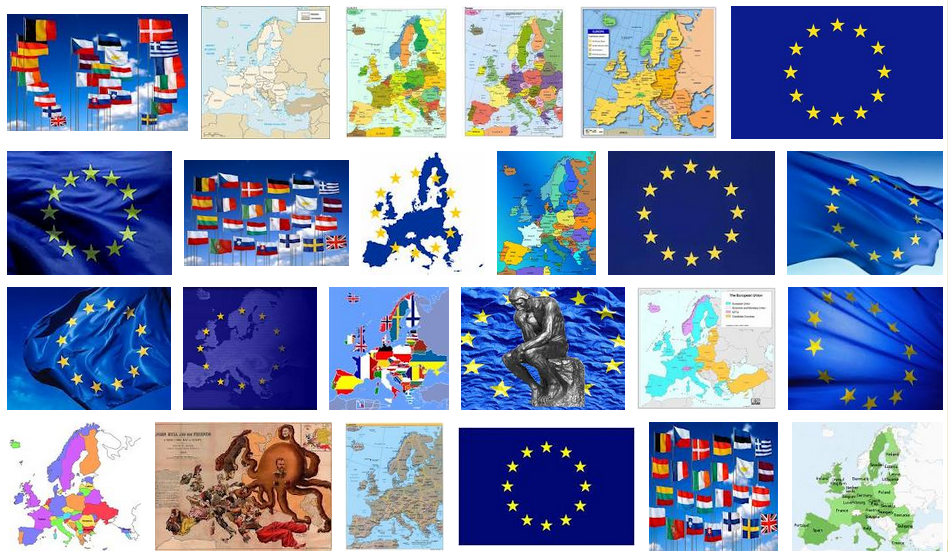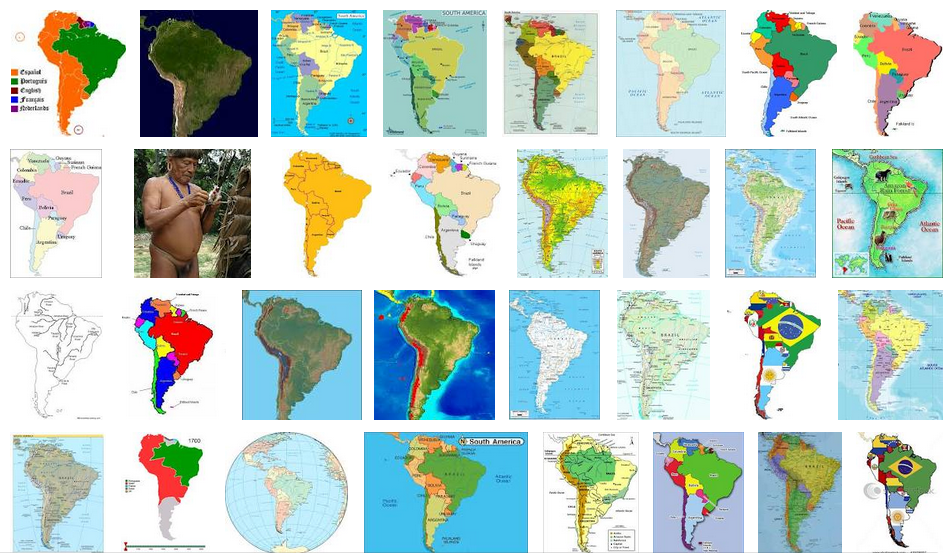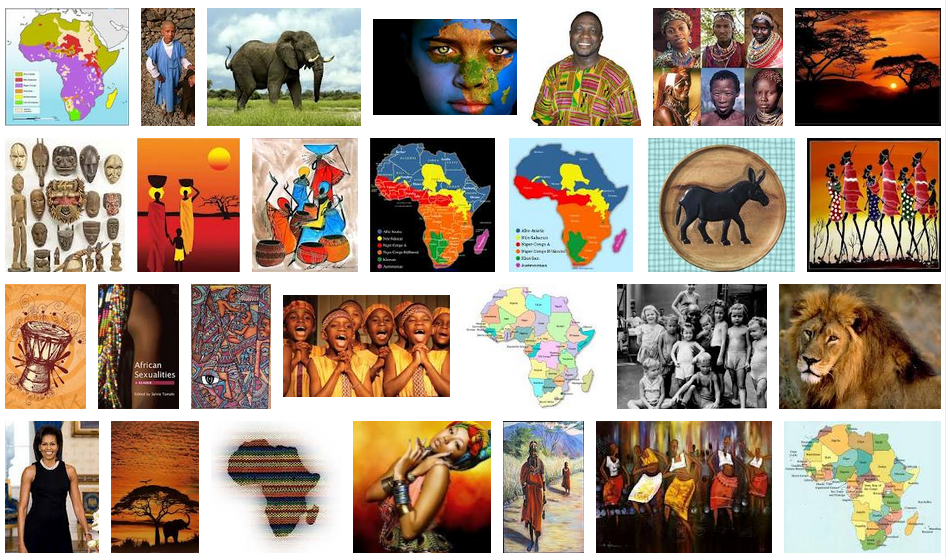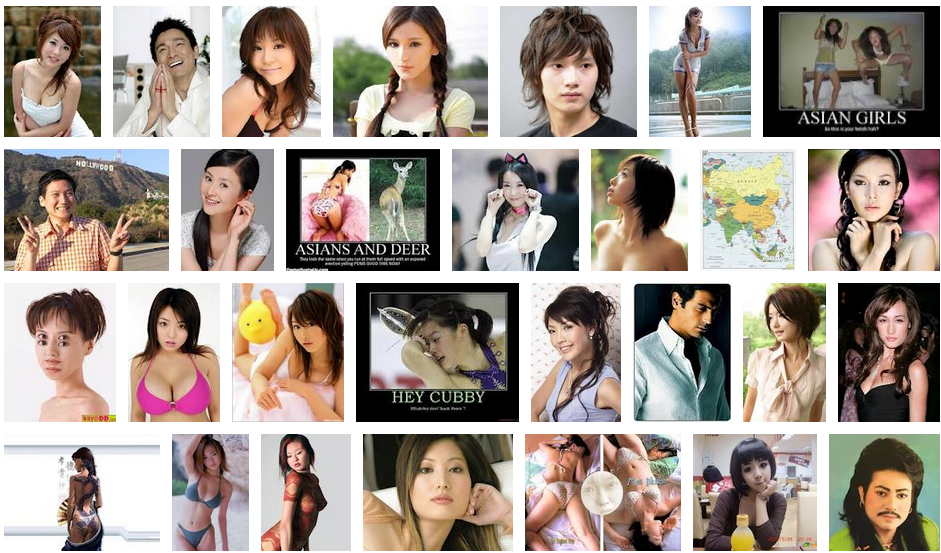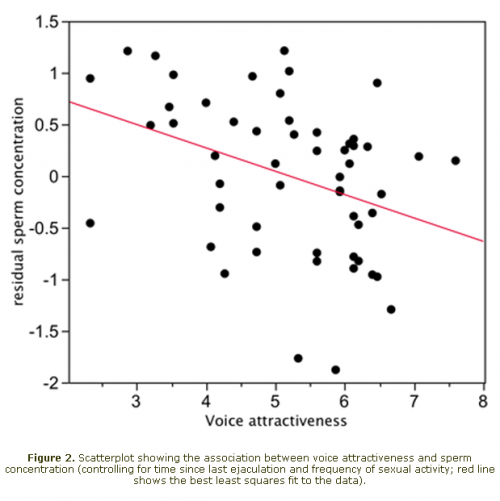The people over at Sociological Cinema did an interesting experiment, searching Google images for the continents. Tell us what you see:
Lisa Wade, PhD is an Associate Professor at Tulane University. She is the author of American Hookup, a book about college sexual culture; a textbook about gender; and a forthcoming introductory text: Terrible Magnificent Sociology. You can follow her on Twitter and Instagram.Evolutionary psychologists argue that when we find certain traits sexually attractive in others it may be because they signal reproductive fitness. It goes something like this: People who have been sexually attracted to traits that tell the “truth” about genetic superiority have been more likely to choose mates with superior genetics and, therefore, have been more likely to produce healthy offspring that live to an age where they, in turn, can reproduce themselves. Accordingly, nature has selected for individuals attracted to people who display signs of genetic excellence.
Culture throws a wrench in this theory because human can create their own systems of meaning, collectively convincing each other that certain traits are desirable regardless of the relationship between the trait and reproductive fitness. The thinness ideal for women is an excellent example. Judging by pop culture, heterosexual men have a strong preference for very thin women. In fact, however, the weight idealized in mass media is not conducive to reproductive fitness; women won’t ovulate or menstruate below a certain weight because their body recognizes that it can’t support a pregnancy.
A new study — by Leigh Simmons, Marianne Peters, and Gillian Rhodes — offers another tantalizing piece of information regarding the relationship between attractiveness and reproductive fitness. Pre-existing research shows that men with lower voices are judged more sexually attractive, so the authors decided to measure one indicator of their reproductive fitness, sperm count.
The results? Voice attractiveness is related to sperm count, but in the opposite direction expected. Men with higher voices, in fact, have higher sperm concentration, not lower.
The jury is still out about what this means, but it’s an intriguing addition to the ongoing conversation that social and biological scientists are having about how culture and nature interact to shape human experience.
Lisa Wade, PhD is an Associate Professor at Tulane University. She is the author of American Hookup, a book about college sexual culture; a textbook about gender; and a forthcoming introductory text: Terrible Magnificent Sociology. You can follow her on Twitter and Instagram.Cross-posted at Global Policy TV.
Recent research has unearthed the interesting finding that most Americans dislike atheists. In fact, they strongly dislike atheists. Surveys suggest that they’d rather share a beer with almost anyone, even members of historically-hated groups: homosexuals, African-Americans, or Muslims (yes, even after 9/11). This phenomenon is new in American society, as I’ll discuss below, and reflects a significant change in our social alliances.
But first, consider this data published by Penny Edgell and her colleagues in the American Sociological Review (full text). It reveals that Americans believe that atheists, more than many other groups, are not likely to agree with their “vision of American society.” Atheists topped the list, beating out the second contender, Muslims, by 13 percentage points. Likewise, among the types of people Americans would not want their children to marry, atheists come first, beating out Muslims (again) by 14 points and African Americans by a full 20.
This dislike for atheists, by the way, isn’t on the wane. While dislike of gays and lesbians has been easing, racism has become increasingly unacceptable, and religious diversity has become less contentious, intolerance for non-believers has held steady.
An even more recent article revealed that the reason people dislike atheists so much has to do with trust (cite). Many people are skeptical that someone who doesn’t believe in God would do the right thing, given that they don’t imagine that a higher power is watching them and keeping score. Atheists were more distrusted than Muslims, Jews, gay men, and feminists. The only group that was as strongly suspected of bad behavior as atheists? Rapists.
What is interesting in all this – above and beyond a clear prejudice against atheists – is the change in how Americans think about religion. Until recently, members of different religious saw each other as enemies, not friends. American history is characterized by “long-standing divisions among Protestants, Catholics, and Jews” (Edgell et al.). Many of us can remember how significant it was to elect the first Catholic president (something we take for granted as unremarkable now) and we are on the precipice of nominating a Mormon to run on the Republican ticket.
Indeed, historical data shows that Americans have been increasingly willing to vote for a Catholic or Jewish Presidential Candidate (as well as an African American and homosexual candidate), but their willingness to vote for an atheist is lagging behind:
The take home point has to do with shifting social alliances. Now that most Americans have abandoned a strong dislike for members of other religions, it’s possible for The Religious to emerge as a socially-meaningful identity group. In other words, once members of different religions begin to see each other as the same instead of different, they can begin to align together. Suddenly atheists become an obvious foe. Instead of one of many types of people who had lost their way (along with people of different faiths), atheists could emerge as uniquely problematic. It is the building of cross-religious alliances, then, that undergirds the strong dislike for atheists specifically.
Lisa Wade, PhD is an Associate Professor at Tulane University. She is the author of American Hookup, a book about college sexual culture; a textbook about gender; and a forthcoming introductory text: Terrible Magnificent Sociology. You can follow her on Twitter and Instagram. W.W. Norton released a couple two-minute interviews in which I talk about hook up culture, part of their collection of academics talking about their research.
W.W. Norton released a couple two-minute interviews in which I talk about hook up culture, part of their collection of academics talking about their research.
In the first clip, I discuss the difference between hooking up and a hook up “culture.” In the second, I respond to the concern that there is something “wrong” with casual sex on college campuses. There is something wrong, I argue, but it’s not unique to casual sex. Instead, the problems students face on campus — heterosexism, gender inequality, and a relentless pressure to be “hot” — don’t go away with graduation.
In that sense, for better or worse, college is a “functional training ground” for the friendships, marriages, workplace interactions, and other types relationships that students will encounter after college; social inequalities threaten the health of all of these relationships. Instead of shaking our fingers at college students, then, we should recognize that the acute problems we see on campuses are symptoms of the ills that characterize our wider sexual culture as well.
I’m speaking about hook up culture at Harvard and Dartmouth this week. If you’re in the area, please come by and say “hello!”
- Monday, Mar. 26th at 8:00pm: “Sex Lives and Sex Lies: Hooking Up on Campus” (Harvard University, Science Center D)
- Wednesday, Mar. 28th at 7:30pm: “Sex Machines vs. Sex Objects: How Stereotypes Subvert Sexual Pleasure” (Harvard University, Fong Auditorium)
- Thursday, Mar. 29th at 4:30pm: “The Promise & Perils of the Hook-Up Culture” (Dartmouth University, Rockefeller Center “Rocky” 2)
The burqa and headscarf are often identified as symbols of women’s oppression in Muslim countries. In fact, head covering is a form of religious garb in many sub-cultures. Some of these subcultures require head covering all of the time, and others only during religious rituals, but all involve this tradition. Yet, when it comes to Muslims, the discussion often goes forward as if it is a uniquely oppressive, and uniquely Islamic, practice. Food for thought.
Thanks to Dolores R. for the link. Found at Socialist Texan.
UPDATE: In the comments, Alastair Roberts suggests that it’s important to consider whether head covering is required for just women, or both women and men. I agree.
Lisa Wade, PhD is an Associate Professor at Tulane University. She is the author of American Hookup, a book about college sexual culture; a textbook about gender; and a forthcoming introductory text: Terrible Magnificent Sociology. You can follow her on Twitter and Instagram.Here we have another great vintage ad (1962) that upsets the idea that today’s norms are trans-historical. First, the idea of having a “pint about midday” would be considered inappropriate by many U.S. employers (though, as several commenters have pointed out, not necessarily elsewhere). Second, the large print — “Beer, It’s Lovely!” — sounds unmasculine today, even though these grizzled sea-farers likely would have seemed perfectly masculine enough at the time.
From the RAF Flying Review, found at Retronaut.
Lisa Wade, PhD is an Associate Professor at Tulane University. She is the author of American Hookup, a book about college sexual culture; a textbook about gender; and a forthcoming introductory text: Terrible Magnificent Sociology. You can follow her on Twitter and Instagram.In 2010 we wrote about how gender ideology inflects even the most “objective” of spheres. In this case, we featured four examples of anatomical illustration, portrayals of human beings used to educate viewers about biology. In each case, while the man faced forward with his weight evenly distributed on his two feet, the woman placed her hand on her hip, cocked a knee, or even turned slightly sideways. In other words, he was posed in a masculine way and she in a feminine way.
When we see this kind of gendered posing in drawings that are ostensibly neutral, we are being told that our particular historically- and culturally-contingent version of masculinity and femininity is natural.
In this vein, Courtney S. sent in a Design by Hümans Size Chart. The chart is supposed to help buyers decide what size to purchase, but the accompanying images do more than just illustrate how measurements are made; by torquing the female torso, they send a message about gender too:
Lisa Wade, PhD is an Associate Professor at Tulane University. She is the author of American Hookup, a book about college sexual culture; a textbook about gender; and a forthcoming introductory text: Terrible Magnificent Sociology. You can follow her on Twitter and Instagram.In an earlier post we reviewed research by epidemiologists Richard Wilkinson and Kate Pickett showing that income inequality contributes to a whole host of negative outcomes, including higher rates of mental illness, drug use, obesity, infant death, imprisonment, and interpersonal trust.
In the six-minute video below, Kate Pickett talks about how more equal societies are kinder to each other, give more in foreign aid, are less status-conscious, consume less, and even recycle more. Based on this, she argues that reducing inequality within societies is a good strategy towards addressing climate change.
How to increase equality? It turns out there are lots of options.
See Dr. Pickett making similar arguments as to why raising the average national income in developed countries doesn’t make people happier or enable them to live longer, why unequal societies are more violent, and how status inequality increases stress.
And see more about income inequality and national well-being at Equality Trust.
Lisa Wade, PhD is an Associate Professor at Tulane University. She is the author of American Hookup, a book about college sexual culture; a textbook about gender; and a forthcoming introductory text: Terrible Magnificent Sociology. You can follow her on Twitter and Instagram.
